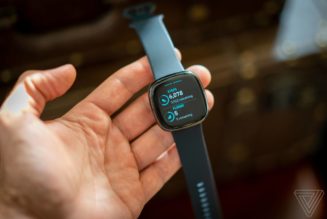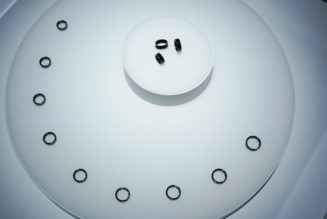When trees and plants disperse their seeds, they often rely on the wind to carry them to pastures new. Different seeds adopt different methods of flight: some glide through the air, others parachute to the ground, and some spin like helicopters on the breeze. For scientists, these aerodynamics have provided the inspiration for a new sort of airborne sensor — tiny fliers, some smaller than a grain of sand and others electronically equipped, that could, in the future, float into the atmosphere for tasks like environmental monitoring.
These fliers, which range in size from around 40mm across (the largest) to 0.4mm across (the smallest), do not move under their own power. Instead, they’ve been designed to linger as long as possible in the air, sustained by their bio-inspired aerodynamic designs.
An international team of scientists led by engineers from Northwestern University developed their shape through physical prototyping and computer simulation. Their best result was a tiny flier that moves at a leisurely maximum speed of 28 cm/sec when falling to the ground (a measure known as terminal velocity). Snowflakes, by comparison, fall at speeds of 250 cm/sec, while the seeds of the ant tree (Triplaris cumingiana) float at rates of 75 cm/sec.
“It was surprising we could do better than seeds in terms of flight dynamics,” John Rogers, a professor of materials science and engineering at Northwestern University who led the development of the fliers, told The Verge. He noted that this was likely because nature has to optimize the design of seeds to balance many different considerations, while the scientists could focus on just a few: payload and flight times.
:no_upscale()/cdn.vox-cdn.com/uploads/chorus_asset/file/22866716/Screen_Shot_2021_09_21_at_12.18.04_PM.png)
As described in a paper published in Nature this week, it’s these payloads that set these fliers apart. Rogers and his team developed many different prototypes, including large units about 40mm in length, which are equipped with battery-free electronics to monitor solar light exposure. And smaller models, two millimeters across, were made from special materials that change color in response to environmental factors, like acidity or the presence of certain elements, such as lead or mercury.
Their ability to collect data means these fliers could be used as environmental monitoring tools, says Rogers. He imagines that clouds of units could be dispersed via airplane or drone for tasks like monitoring chemical spills or atmospheric pollution. The fliers would collect data as they float to the ground or when they touch down. For the larger units, tiny antennas could send back information wirelessly to a home receiver, or, in the case of the color-changing fliers, aerial photography could be used to snap pictures of the fliers from above to collect the required data.
But despite Rogers’ ambitious vision for the fliers, there are many unanswered questions about practical, economical, and environmental aspects of the design. Núria Castell, a senior scientist who works on pollution monitoring techniques at the Norwegian Institute for Air Research (NILU), told The Verge that collecting data in the way Rogers’ team envisions would limit the potential applications of this technology.
:no_upscale()/cdn.vox-cdn.com/uploads/chorus_asset/file/22866720/Screen_Shot_2021_09_21_at_12.19.22_PM.png)
“I was thinking, do we really need this? How is this going to work?” says Castell. She notes that for her own research — measuring air pollution in cities — the fliers offered more problems than solutions. They are too small to carry sensitive equipment; they only collect data from relevant elevation levels for a brief time during their journey to the ground; and they would need to be dispersed again and again to capture data over longer time periods. These are all problems best solved using existing technology, says Castell. “How many of these [fliers] would you need to measure data for even just one week?”
The engineering and physics research that has gone into designing the fliers is worthy of praise, says Castell. She adds that although they might not be practical for regular data collection, they might be extremely useful in emergency scenarios. “They could use it for biohazard accidents,” she says. “I’m talking about very serious events where you need an immediate response.” In such an event, a drone could quickly fly out and disperse the fliers over the affected area to gather a quick snapshot of the damage of the accident.
:no_upscale()/cdn.vox-cdn.com/uploads/chorus_asset/file/22866719/Screen_Shot_2021_09_21_at_12.18.39_PM.png)
Another potential issue with the fliers is that, as single-use items, they might generate waste. But Rogers says he and his team have been working to eliminate this by pairing the fliers with a new class of dissolvable electronics that would minimize their environmental impact. “We considered that problem pretty deeply,” he says. “We have some demonstrations we’ll be publishing soon where all of the electronics just disappear and wash away in rainwater over a period of time.”
Ultimately, though, the fliers are still a preliminary design. The fabrication techniques are well developed, says Rogers, but the fliers themselves have only been tested in controlled environments — not in large-scale deployments in the wild. “It’s still early days,” he says. “But at the same time, we’ve thought pretty deeply about which ideas scale and which don’t, and we’ve focused on concepts that can be scaled and ideas that are practically relevant. We’ll be looking for partnerships to take the technology out of the lab.”









